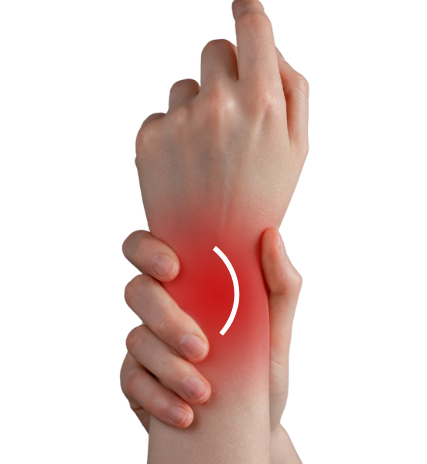Wrist Tenosynovitis
About Wrist Tenosynovitis
Wrist Tenosynovitis also called ‘De Quervain’s tendinosis’ is an inflammation of the tendons of the thumb. This is one of the most common types of tendon lining inflammation. Women are affected by this condition eight to ten times more than men. This condition has also been called “Mummy’s wrist” due to repetitive strain injury from lifting and carrying a newborn baby.
What Causes Wrist Tenosynovitis
Wrist Tenosynovitis is a condition that is caused by several factors, including:
- Repetitive grasping of thumb and fingers and twisting of the wrist
- A direct blow to the thumb
- Menopausal women
Some activities that require a sidewise motion of the wrist while you are gripping the thumb can aggravate this condition like:
- Wringing and drying of wet clothes
- Pouring of water from a jug or kettle
- Opening of doors and turning of keys
- Using hammer
- Racquet sports
- Gardening

Symptoms Of Wrist Tenosynovitis
Pain
Difficulty moving your thumb
Swelling
When Should I Seek Medical Attention?
You should seek medical help when:
- Swelling of the wrist joint
- Persistent wrist pain from moving the thumb
- Inability to rotate the wrist
- Tenderness at the location of pain
Diagnosing Wrist Tenosynovitis
Diagnosing Wrist Tenosynovitis is usually done with a Finkelstein test. It is a simple physical examination to determine the condition. Additionally, our team of experienced primary care physicians and pain care specialists will conduct a thorough diagnosis by evaluating your medical history. This is a clinical diagnosis and rarely does it need any MRI investigation.
A Message About Wrist Tenosynovitis
Wrist Tenosynovitis is a very painful and disabling condition. If left untreated, the pain would progress to weakness and increasing disability. There would be great inconvenience using the hand due to pain inhibition from the wrist and base of the thumb. During the initial phase, rest and immobilisation is the key to preventing it from getting worse.
Fortunately, while this condition can be very disabling with a significant handicap of using the affected hand, it can be treated very effectively with a simple injection into the inflamed tendon sheath.
Myospan injection of local anaesthetic, anti-inflammatory and muscle relaxant will provide almost immediate pain relief. Combined with regular physical therapy, it will prevent the recurrence of tenosynovitis.
What Treatments Are Available for Wrist Tenosynovitis?
Wrist Tenosynovitis can be easily resolved with non-surgical methods. At Singapore Paincare, we strive to treat your pain with the least invasive option possible after accurately identifying the cause. Our approach to pain resolution focuses on the removal of pain generators via specialised injection and minimally invasive procedures. Combined with pharmacological treatments and cognitive and physical rehabilitative therapies – we help patients improve functions and prevent pain from recurring.
Non-Surgical Treatment for Wrist Tenosynovitis
Splinting
Steroid Injections
Myospan treatment addresses both local and referred causes. Our Coreflex injections use a mix of local anaesthetic, anti-inflammatory and muscle relaxant, to be injected into the affected tendon sheath as well as any strained surrounding distal muscles and ligaments.
Physiotherapy
Surgical Treatment for Wrist Tenosynovitis
Wrist tenosynovitis is usually an inflammatory condition. In rare cases, it may be due to restriction or compression from the tight retinaculum band of the wrist. In these cases, if non-surgical treatments do not reduce pain and swelling, surgery may be recommended.
Surgical release of the tendon
Home Remedies for Wrist Tenosynovitis
Alternatively, you can also use a hot or cold compress. The cold compress or ice reduces the pain felt from the area of inflammation. A hot compress is usually used after a few days of a cold compress to stimulate the blood flow.
How Can I Prevent Wrist Tenosynovitis?
By taking breaks and staying away from the actions that further aggravate the condition, you can reduce the chance of it returning after treatment. Identify the triggering activities that may cause strain injuries to your wrist and avoid these movements. Your doctor will advise you on what events aggravate the condition and what to avoid.
Get Your Pain Resolved
Send your enquiries or consult our pain experts today.


